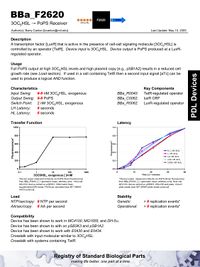Endy:F2620: Difference between revisions
From OpenWetWare
Jump to navigationJump to search
Barry Canton (talk | contribs) No edit summary |
|||
| (37 intermediate revisions by 3 users not shown) | |||
| Line 1: | Line 1: | ||
[[Image: | __NOTOC__ | ||
==Introduction== | |||
[[Image:F2620.de2.jpg|right|thumb|200px|Drew's datasheet]] | |||
We are working to comprehensively characterize a receiver device to enable cell-cell communication. F2620 is a receiver device that responds to the presence of a signaling molecule in the extracellular media by activating transcription from a regulated promoter. Our aims are to provide a well-characterized receiver device to the biological engineering community and secondly to develop a framework for device characterization that can be adapted to characterize other devices that can be used to build modular biological systems. Further details about this work can be found on the [http://parts2.mit.edu/registry/index.php/Featured_Parts:Cell-Cell-Signaling cell-cell signaling page] of the [http://parts.mit.edu/registry registry]. | |||
== | ==Characterization data== | ||
{|{{Table}} | |||
!Experiment | |||
!Protocol | |||
!Data | |||
|- | |||
|[[Endy:F2620/Transfer Curve|Transfer Curve]] | |||
|[[Endy:F2620/Transfer Curve/Protocols|protocol]] | |||
|[[Endy:F2620/Transfer Curve/Data|data]] | |||
|- | |||
|[[Endy:F2620/Specificity|Specificity]] | |||
|[[Endy:F2620/Specificity/Protocols|protocol]] | |||
|[[Endy:F2620/Specificity/Data|data]] | |||
|- | |||
|[[Endy:F2620/Latency|Latency]] | |||
|[[Endy:F2620/Latency/Protocols|protocol]] | |||
|[[Endy:F2620/Latency/Data|data]] | |||
|- | |||
|[[Endy:F2620/Stability|Stability]] | |||
|[[Endy:F2620/Stability/Protocols|protocol]] | |||
|[[Endy:F2620/Stability/Data|data]] | |||
|} | |||
*[[Endy:F2620/Experiments Pending|Experiments Pending]] | |||
*[[Endy:F2620/Calibration|Calibration]] | |||
*[[Endy:F2620/Machine variation|Machine variation]] | |||
*[[Endy:F2620/Data Processing|Data Processing]] | |||
*[[Endy:F2620/Data/Archive|Old data plots and discussion of data-processing methods]] | |||
[[ | ==Communications== | ||
*[[Endy:F2620/Nature Biotech draft|Nature Biotech. draft]] | |||
*[[Endy:F2620/Figures]] | |||
*[[Nat Biotech Guidelines]] | |||
*[[Endy:F2620/Miscellaneous communications|Other communications]] | |||
[[ | ==F2620 Data Sheets== | ||
*[http://model.mit.edu/endipedia/images/7/7b/F2620.bc1.ppt Barry's first draft (.ppt file)] | |||
*[http://model.mit.edu/endipedia/images/2/25/F2620.de2.ppt Drew's improved version (.ppt file)] | |||
*[http://parts.mit.edu/registry/index.php/Part:BBa_F2620 F2620 Registry page] | |||
*[[Endy:F2620/Data sheet versions|Other data sheet versions]] | |||
<math> | |||
P_{out} = \frac{P_{max}[3OC_6HSL]^n}{K^n+[3OC_6HSL]^n} | |||
= | </math> | ||
Latest revision as of 09:26, 11 February 2008
Introduction

We are working to comprehensively characterize a receiver device to enable cell-cell communication. F2620 is a receiver device that responds to the presence of a signaling molecule in the extracellular media by activating transcription from a regulated promoter. Our aims are to provide a well-characterized receiver device to the biological engineering community and secondly to develop a framework for device characterization that can be adapted to characterize other devices that can be used to build modular biological systems. Further details about this work can be found on the cell-cell signaling page of the registry.
Characterization data
| Experiment | Protocol | Data |
|---|---|---|
| Transfer Curve | protocol | data |
| Specificity | protocol | data |
| Latency | protocol | data |
| Stability | protocol | data |
- Experiments Pending
- Calibration
- Machine variation
- Data Processing
- Old data plots and discussion of data-processing methods
Communications
F2620 Data Sheets
- Barry's first draft (.ppt file)
- Drew's improved version (.ppt file)
- F2620 Registry page
- Other data sheet versions
[math]\displaystyle{ P_{out} = \frac{P_{max}[3OC_6HSL]^n}{K^n+[3OC_6HSL]^n} }[/math]